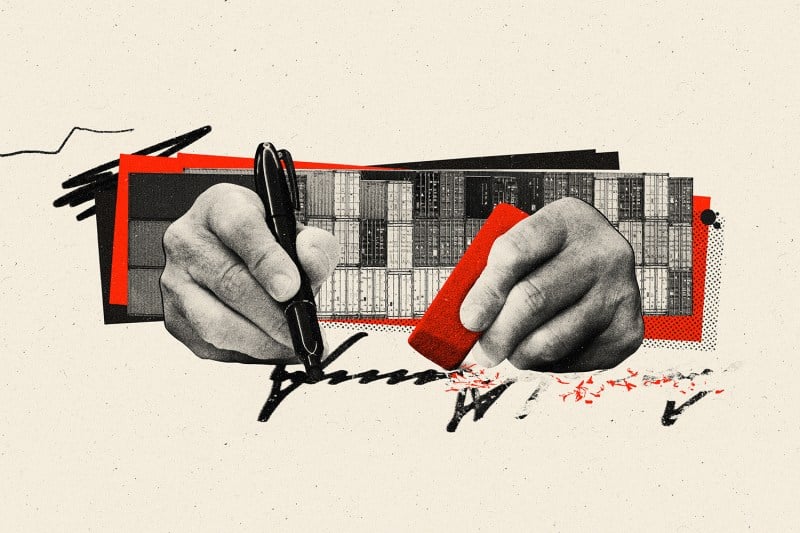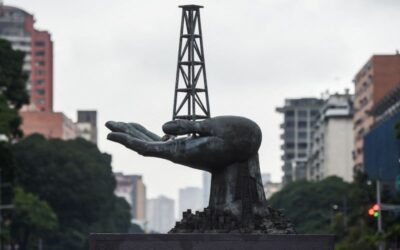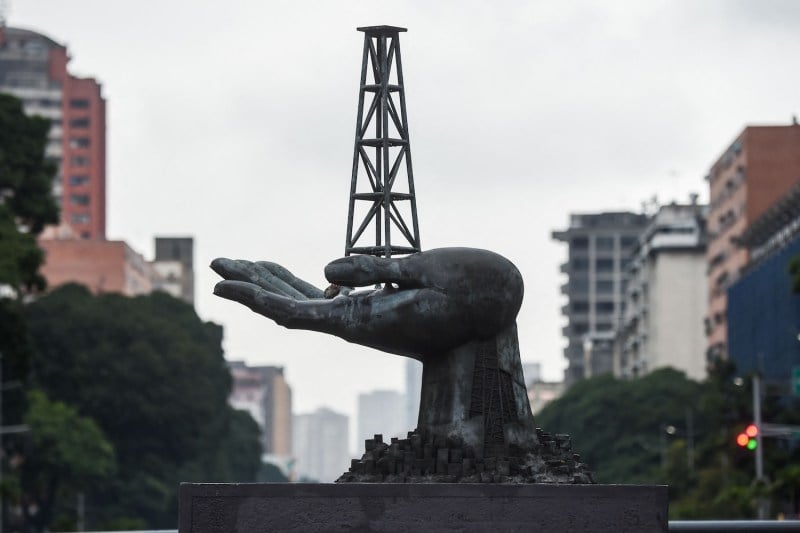Will Trump Back Down From a Global Trade War?

Will Trump Back Down From a Global Trade War?
The U.S. president still has plenty of outs from his extreme tariffs.
Klawe Rzeczy illustration for Foreign Policy/Getty Images
As comedian Oliver Hardy might have said to U.S. President Donald Trump about his tariffs, “Here’s another nice mess you’ve gotten us into.” On the first full day of trading after his announcement, U.S. markets had their biggest rout since the early days of the COVID-19 pandemic in 2020, as the Dow Jones Industrial Average fell 1,679 points.
Now what?
As comedian Oliver Hardy might have said to U.S. President Donald Trump about his tariffs, “Here’s another nice mess you’ve gotten us into.” On the first full day of trading after his announcement, U.S. markets had their biggest rout since the early days of the COVID-19 pandemic in 2020, as the Dow Jones Industrial Average fell 1,679 points.
Now what?
If markets continue to tank and Trump’s poll numbers decline, it’s a good bet that he will look for a way to ease the pain. His comment that he “couldn’t care less” if auto prices rise because of tariffs? Don’t believe it. His responses to market pressure during his first-term trade war with China give some clues about the likely paths he would take if he decided to back down or if others challenged him—some more probable than others.
Most Likely
Exclusions. Among the most head-scratching part of Trump’s Wednesday announcement was the absence of what are called “exclusions”—industries or products that are exempted from tariff increases. As Dartmouth College trade historian Douglas Irwin has pointed out on X, Trump didn’t even exclude what he estimated as the two-thirds of imports that usually come in duty-free. They include such staples as coffee, tea, and bananas, which the United States produces in tiny quantities.
During Trump’s first trade war, his U.S. trade representative was careful not to hit China with tariffs on expensive consumer goods such as mobile phones and laptops. Not this time. From April 9, iPhones shipped from China will be tagged with as much as a 54 percent tariff. A big increase in prices is bound to add political pressure on Trump to reduce levies.
The first Trump administration also conducted lengthy hearings in which companies asked for exemptions from tariffs because they couldn’t find alternatives for Chinese imports. ProPublica called the proceedings “a blessing for one set of players: Washington’s influence industry, including the firms of former Trump officials and allies,” which represented the companies seeking to avoid a tariff hit.
Expect a similar process this time around, too. Exclusions ease the impact of tariffs, which should please markets and importers. They also give Trump yet another chance to play kingmaker by deciding which products and companies to help and which to hinder—and to demand favors from them in return.
On Thursday, the White House started to move in that direction, providing a long list of product categories that would be exempt from the new tariff moves, describing them in language only a trade lawyer would love. The Wall Street Journal reported that the goods included energy products, some minerals, and chemicals used in energy, manufacturing, and more. Expect to hear more on this front.
Fire someone. It’s long been a Trump verity that he shifts responsibility for disaster—sometimes to people who had little to do with it. On Thursday, he fired six National Security Council officials after complaints from far-right conspiracy theorist Laura Loomer and the embarrassment of Signalgate.
On the trade front, the most likely scapegoat is Commerce Secretary Howard Lutnick, who has been Trump’s loudest public advocate on trade. On Thursday, he told CBS that Trump wouldn’t back down if the markets fell and told CNBC that Trump wouldn’t go for exemptions. “I don’t think the word exemption is going to be a factor,” he said. Last month, he said tariffs would be “worth it” even if they led to a recession—though he quickly blamed any possible recession somehow on former President Joe Biden.
Lutnick publicly claimed the trade portfolio, which was a surprise to many Trump watchers who expected Robert Lighthizer, his former top trade official, to return to the cabinet. Lighthizer would be the obvious replacement for Lutnick. He, like Trump, is a tariff hawk, but unlike his former boss, he proceeds in an orderly way that reduces political pressure to reverse course. In his book No Trade Is Free, he advocates for eliminating the trade deficit with China, for instance, but doing it over many years.
Somewhat Likely
Declare victory. Trump’s first trade war ended when the United States signed a Phase One trade deal with China in January 2020 that did little to change Beijing’s economic policies but promised big purchases (which China never lived up to). At the time, Trump was feeling pressure to end a two-year trade war as presidential elections loomed and he needed a deal he could claim as a victory.
This time, Trump doesn’t have the immediate pressure of federal elections, but the recent loss in the Wisconsin Supreme Court election was a blow. And there are plenty of ways for Trump to declare victory if he wants to go that way.
Israel, for instance, has ended tariffs on the United States as a way—so far unsuccessful—of getting Trump to back off. Mexico also has been wary of retaliating, and Japan, which is now facing a 24 percent tariff, has never retaliated in the postwar era against U.S. trade sanctions because it is so dependent on U.S. military protection.
With enough of these “victories,” substantial or symbolic, Trump could finagle a way to back off more broadly on his threats. Talking to reporters on Air Force One, he said he might be interested in making deals with countries to remove tariffs “as long as they’re giving us something that’s good.”
Less Likely
Judicial action. Trump cites the International Emergency Economic Powers Act (IEEPA) as giving him the authority to enact massive global tariffs. IEEPA confers broad powers on the president “to deal with any unusual and extraordinary threat.” But does the U.S. trade deficit qualify, given that the country has run a trade deficit every year since 1976?
During the first Trump trade war, Treasury Secretary Steven Mnuchin refused to use IEEPA to justify trade sanctions because he was concerned about preserving the credibility of the dollar as a reserve currency, so the question of presidential authority wasn’t litigated.
Yet precedence suggests that courts would be cautious in acting. Back in August 1971, President Richard Nixon used a precursor to IEEPA to declare a 10 percent global tariff—the so-called Nixon shock—as a way to pressure Japan and West Germany to revalue the dollar. He ended the tariff four months later when the Group of 10, which were the 10 largest economies at the time, agreed to a devaluation under the Smithsonian Agreement.
Several big importers sued Nixon, arguing that he lacked the authority to impose the tariff, but they lost. The now-defunct U.S. Court of Customs and Patent Appeals ruled that Nixon’s actions were a “reasonable response to the particular national emergency.”
The lesson is that courts often defer to the president when it comes to interpretations of national security powers.
Don’t Count on It
Congressional action. Congress has the power to repeal the emergency or take back its constitutional role in setting tariffs. But that would require Republicans to buck the president, and even if they did, Trump could veto such a measure unless it gets to currently politically unthinkable margins.
Although four Republican senators recently voted with Democrats to block tariffs on Canadian goods, that measure isn’t expected to go anywhere in the House. A temporary repudiation of Congress’s own powers to cancel an emergency was also slipped into the recent spending bill.
But backing off isn’t a certainty.
Yes, Trump keeps a close eye on market reaction when he makes tariff threats. During his first-term trade war, for instance, after his tweet about being a “Tariff Man” tanked the market in December 2018, Trump looked for a market rebound by tweeting that he and Chinese President Xi Jinping were once again negotiating for a deal, although it wasn’t clear they were actually talking then.
Trump’s first National Economic Council director, Gary Cohn, said in a radio interview in March 2019: “What are the benchmarks for success of the presidency? The stock market is the most obvious, most transparent, most-talked-about-by-the-president benchmark of success.”
But it’s also true that Trump doesn’t like to look as if he’s backing down—and his advisors in this administration are far less able to convince him not to whack his opponents. At various times during his first term, when China retaliated against U.S. tariffs, Trump immediately threatened to bump levies higher, at least until markets reacted and he cooled off. The huge U.S. trade deficit meant that reducing trade was bound to hurt China more than the United States, he believed, and gave him room to act. “They’ll run out of bullets first,” several of his aides told me he said.
This time, Trump has literally taken on the whole world, not just China. It’s an open question whether he’ll react more viscerally to a market decline, which might get him to ease off tariffs, or to tough retaliation, which could cause him to dig his heels. China has already struck back with 34 percent tariffs across the board and a range of probes into U.S. firms.
Lutnick says Trump won’t back off. But a lot of Trump cabinet officials have lost their jobs and reputations thinking that they understood what their mercurial boss would do next.
This post is part of FP’s ongoing coverage of the Trump administration. Follow along here.
Bob Davis is a reporter who covered U.S.-China economic relations for decades for the Wall Street Journal. He is the co-author of Superpower Showdown: How the Battle Between Trump and Xi Threatens a New Cold War. X: @bobdavis187
More from Foreign Policy
-

An illustration shows a golden Cybertruck blasting through a U.S. seal of an eagle holding arrows and laurel. Is America a Kleptocracy?
Here’s how life could change for the rich, poor, and everyone in between.
-

The flag of the United States in New York City on Sept. 18, 2019. America Is Listing in a Gathering Storm
Alarms are clanging at the U.S. geographic military commands around the globe.
-

U.S. President Donald Trump shakes hands with Supreme Court Chief Justice John Roberts during Trump’s inauguration in Washington, D.C. The U.S. Judicial Crisis Is Uniquely Dangerous
But other democracies provide a roadmap for courts to prevail over attacks from the executive branch.
-

An illustration shows a golden Newtons cradle with Elon Musk depicted on the one at left and sending a globe-motif ball swinging at right. Elon Musk’s First Principles
The world’s richest man wants to apply the rules of physics to politics. What could go wrong?









Join the Conversation
Commenting on this and other recent articles is just one benefit of a Foreign Policy subscription.
Already a subscriber?
.
Subscribe
Subscribe
View Comments
Join the Conversation
Join the conversation on this and other recent Foreign Policy articles when you subscribe now.
Subscribe
Subscribe
Not your account?
View Comments
Join the Conversation
Please follow our comment guidelines, stay on topic, and be civil, courteous, and respectful of others’ beliefs.
Change your username |
Log out
Change your username:
CANCEL
Confirm your username to get started.
The default username below has been generated using the first name and last initial on your FP subscriber account. Usernames may be updated at any time and must not contain inappropriate or offensive language.